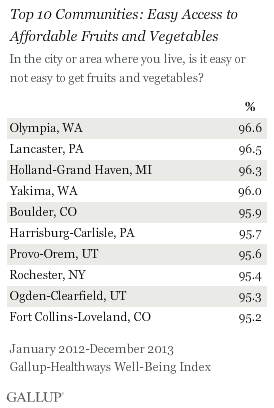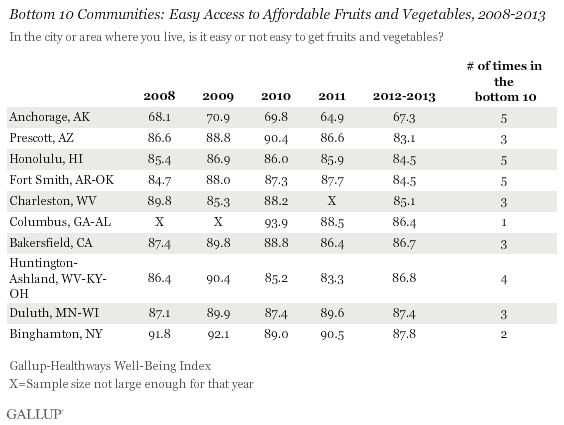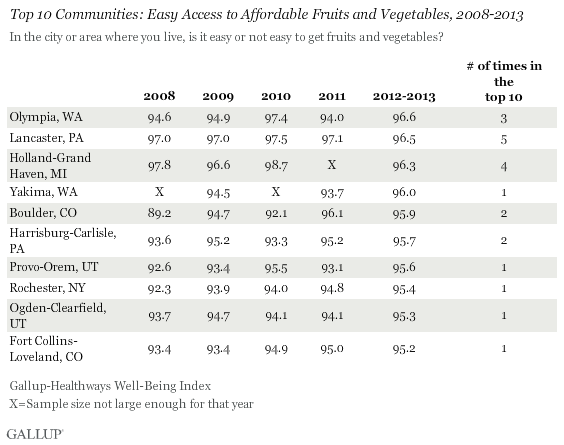WASHINGTON, D.C. -- Residents of Anchorage, Alaska (67.3%) were the least likely among 189 metro areas nationwide to report having easy access to affordable fruits and vegetables in 2012-2013, a spot it has held since Gallup-Healthways began tracking Americans' access to basic necessities in 2008. Residents of Olympia, Wash. (96.6%) were the most likely to report having easy access to affordable fruits and vegetables, followed by Lancaster, Pa. (96.5%) and Holland-Grand Haven, Mich. (96.3%).


These results are from the Gallup-Healthways Well-Being Index interviews with at least 300 adults aged 18 and older in each of 189 MSAs over a two-year span, from January 2012 through December 2013. Each MSA sample is weighted to match the demographic characteristics of that area. Gallup categorizes U.S. metro areas according to the U.S. Office of Management and Budget's definitions for Metropolitan Statistical Areas (MSAs).
Nationally, an average 90.9% of Americans said they have easy access to affordable produce in the city or area where they live in 2012-2013. This figure has hovered around the 90% mark since Gallup's initial 2008 measurement.
Communities With Low Access to Affordable Produce Similar in Previous Years
The 10 communities with the lowest percentages of residents reporting easy access to affordable produce have been fairly consistent from year to year. Columbus, Ga.-Ala. (86.4%) is the only community that is new to the list in 2012-2013. Binghamton, N.Y., has only been in the bottom 10 two out of the past five reporting periods, while all other metros have appeared at least three times.
Three communities have ranked among the bottom 10 each year since 2008: Anchorage; Honolulu, Hawaii (84.5%); and Fort Smith, Ark.-Okla. (84.5%). Anchorage has had the lowest percentage of residents reporting easy access since 2008, with a high of 70.1% in 2009 and falling to a low of 64.9% in 2011.

Lancaster Consistently Ranks Among the Most Produce-Accessible Communities
Of the 10 communities with the greatest access to affordable fruits and vegetables, about half are new to the list, including Yakima, Wash. (96%); Provo-Orem, Utah (95.6%); Rochester, N.Y. (95.4%); Ogden-Clearfield, Utah (95.3%); and Fort Collins-Loveland, Colo. (95.2%).
Lancaster has been among the 10 communities most likely to have easy access to produce every year since Gallup and Healthways began tracking in 2008. Holland-Grand Haven and Olympia have been on the top 10 list four and three times, respectively. All but one of the communities--Boulder-- have consistently maintained 90% of community residents or more who report having easy access to affordable fruits and vegetables across all years. Overall, there is less consistency among the top 10 as opposed to the bottom 10 because of the fact that so many of the communities are tightly clustered around the 95% mark, whereas the bottom 10 percentages are more staggered.

Bottom Line
"Access to affordable produce is essential for individuals, communities, and businesses interested in improving their physical and overall well-being," said Ann Kent, Sr. Vice President, Blue Zones Project. "Fruits and vegetables are packed with disease-fighting nutrients, and frequent consumption can lead to not only higher well-being but also increased life expectancy."
The good news for all major U.S. metropolitan areas is that the overwhelming majority of their residents feel they have easy access to affordable fruits and vegetables.
Since Gallup began asking residents about their access to affordable produce in 2008, only two metros -- one being Anchorage -- have ever had less than 80% of their residents report easy access to produce -- and the national average has never dropped below 89.9%.
Anchorage, however, is an extreme outlier from other U.S. communities, with a significantly lower percentage of its residents reporting easy access to affordable produce than all other communities since 2008. This isn't particularly surprising given Alaska's extreme seasonal variations and generally colder climate and distance from the continental U.S.
Honolulu, too, has repeatedly ranked among the bottom 10 communities for easily accessible and affordable produce, also likely due to Hawaii's remote location. However, aside from Anchorage and Honolulu, Gallup has found differences greater than 10 percentage points in metro-residents' access to affordable produce, and this could have significant variations in economic and health consequences for these communities.
Survey Methods
Results are based on telephone interviews conducted as part of the Gallup-Healthways Well-Being Index survey Jan. 2-Dec. 29, 2012, and Jan. 2-Dec. 30, 2013, with a random sample of 531,630 adults, aged 18 and older, living in metropolitan areas in the 50 U.S. states and the District of Columbia, selected using random-digit-dial sampling. Two years of data were aggregated together to enable the same number of reportable cities as in prior years, when the overall annual data collection exceeded 350,000 interviews per year compared to 178,072 interviews conducted in 2013. At least 300 cases are required per metro area for reporting.
The metro areas referenced in this article are based on the Metropolitan Statistical Areas (MSAs) as defined by the U.S. Office of Management and Budget. In many cases, more than one city is included in the same MSA. The San Jose, Calif., metropolitan statistical area, for example, also includes the smaller nearby cities of Sunnyvale and Santa Clara in addition to San Jose itself. Each respondent is attributed to his or her MSA based on the self-report of his or her ZIP code, and all metro areas had at least 300 completed surveys in the 2012-2013 data collection period.
Maximum expected error ranges for the Well-Being Index and the sub-index scores vary according to MSA size, ranging from less than 1 point for the largest cities represented to ±1.5 points for the smallest cities.
Interviews are conducted with respondents on landline telephones and cellular phones, with interviews conducted in Spanish for respondents who are primarily Spanish-speaking. Each sample of national adults includes a minimum quota of 50% cellphone respondents and 50% landline respondents, with additional minimum quotas by time zone within region. Landline and cellular telephone numbers are selected using random-digit-dial methods. Landline respondents are chosen at random within each household on the basis of which member had the most recent birthday.
Samples are weighted to correct for unequal selection probability, nonresponse, and double coverage of landline and cell users in the two sampling frames. They are also weighted to match the national demographics of gender, age, race, Hispanic ethnicity, education, region, population density, and phone status (cellphone only/landline only/both, and cellphone mostly). Demographic weighting targets are based on the most recent Current Population Survey figures for the aged 18 and older U.S. population. Phone status targets are based on the most recent National Health Interview Survey. Population density targets are based on the most recent U.S. census. All reported margins of sampling error include the computed design effects for weighting.
In addition to sampling error, question wording and practical difficulties in conducting surveys can introduce error or bias into the findings of public opinion polls.
For more details on Gallup's polling methodology, visit www.gallup.com.

